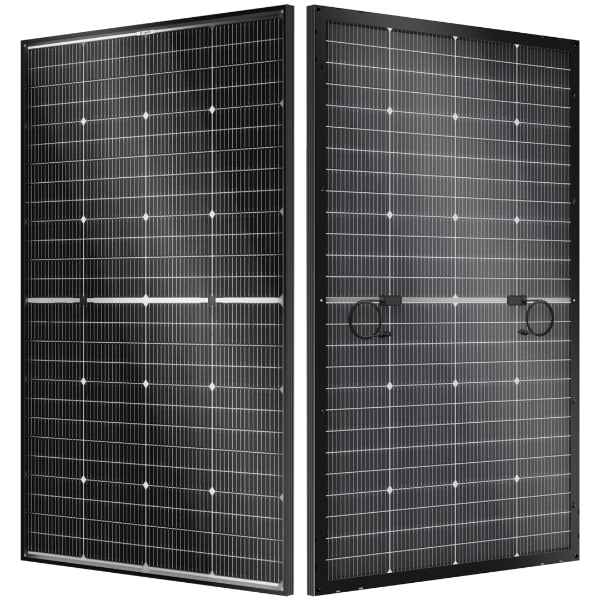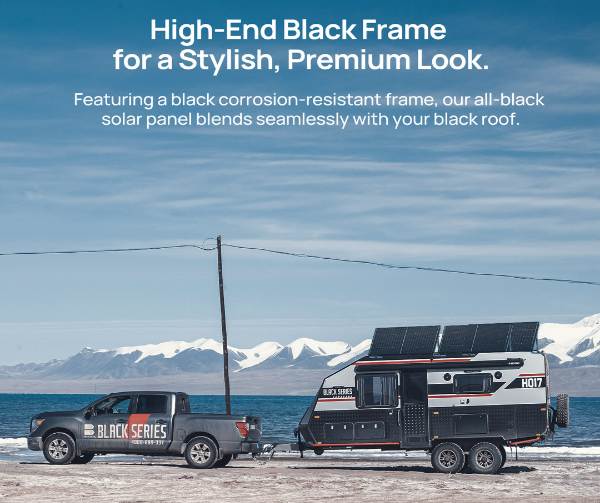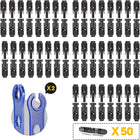What Is a TOPCon Solar Panel?

Solar panel technology continues to evolve, becoming more efficient and accessible. One of the latest advancements in this field is the Tunnel Oxide Passivated Contact (TOPCon) solar panel, which represents a significant leap forward from conventional solar technologies.
In this blog, we'll dive into what TOPCon solar panels are, The difference between TOPCon, PERC, and HJT solar panels, and why TOPCon solar panels might be the right choice for harnessing solar energy.
Let’s dive in!
What Is TOPCon Solar Panel?

TOPCon stands for “Tunnel Oxide Passivated Contact.” It's a kind of solar panel technology that aims to enhance solar cell efficiency by minimizing the electronic losses typically associated with silicon solar cells.
TOPCon solar panels are known for their high efficiency and improved temperature coefficients. They can perform better at high temperatures compared to p-type cells, PERC, and HJT technologies. Additionally, they offer higher durability due to lower degradation rates over time.
TOPCon Solar Cell Structure
The structure of a TOPCon solar cell includes an ultra-thin tunneling oxide layer situated between the n-type silicon substrate and a highly doped polysilicon layer. This innovative configuration improves light absorption and reduces electron recombination rates, thus enhancing overall cell efficiency.
Therefore, TOPCon solar panels also perform better in low-light and shaded conditions, making them ideal for use in cloudy or shaded areas.
In addition, the TOPCon technology contributes to a higher durability. Its thin tunneling oxide layer protects the cell from moisture and temperature fluctuations, which can cause degradation.
TOPCon Solar Cell Efficiency
Due to their unique structure, TOPCon solar cells have achieved a maximum efficiency of up to 28% under laboratory conditions. This figure exceeds the approximate 24% maximum efficiency reported for PERC cells. TOPCon cells are more efficient in converting sunlight into electricity than P-type cells.
What Is the Difference Between TOPCon and N-Type Solar Panels?

N-type solar panels utilize silicon that has been doped with an element like phosphorus, which adds extra free electrons, thereby giving the material an overall negative charge carrier concentration. This characteristic makes them more efficient and less prone to certain types of degradation such as light-induced degradation (LID), compared to traditional P-type solar cells.
TOPCon (Tunnel Oxide Passivated Contact) cells represent a specialized approach within the family of n-type solar cells. This technology includes the addition of a tunnel oxide layer and a subsequent highly doped polysilicon layer on the back surface of the cell. This structure further enhances the cell's efficiency by reducing electronic recombination and minimizing energy losses.
All TOPCon cells are n-type due to their negative charge carrier concentration, but not all n-type cells use the TOPCon architecture. TOPCon can be considered one of the advanced designs implemented in high-efficiency n-type cells.
Compared to their P-type counterparts, n-type cells, including those using TOPCon technology, typically exhibit higher efficiencies and better performance at high temperatures, along with reduced susceptibility to both LID and potential induced degradation (PID). However, this enhanced performance comes with higher manufacturing costs, which affects the final price of the solar panels.
What is the Difference Between TOPCon, PERC, and HJT Solar Panels?
TOPCon solar panels feature a simpler manufacturing process and are less sensitive to humidity compared to other technologies. Although Mono PERC panels have a manufacturing process that is simpler than both HJT (Heterojunction Technology) and TOPCon panels, they offer lower efficiency and bifacial capabilities than HJT panels.
Perc vs. TOPCon vs. HJT Comparison Chart
|
TOPCon Solar Cells |
PERC Solar Cells |
HJT Solar Cells |
|
|
Efficiency |
Up to 28.7% |
24.5% |
27.5% |
|
Manufacturing Complexity |
Moderate |
Low to moderate |
High |
|
Cost |
Higher |
The Most Cost-Effective |
Medium |
|
Temperature Coefficient |
Better Performance at High Temps |
Moderate |
Better Performance at High Temps |
|
Sensitivity to Humidity |
Less Sensitive |
More Sensitive |
Moderate |
|
Light Absorption |
Good |
Good |
Excellent |
|
Bifaciality |
80% |
75% |
95% |
|
Life Span |
25-30 Years |
25-30 Years |
30 Years |
What Is the Difference Between TOPCon and PERC Solar Panels?
TOPCon and PERC primarily differ in the type of silicon used and their cell structure. TOPCon technology is viewed as an evolution of PERC technology, further optimizing solar cell efficiency and performance, particularly for hot climates and degradation resistance.
-
Type of Silicon
PERC typically employs p-type silicon wafers doped with boron to create an excess of holes (positive charge carriers). In contrast, TOPCon uses n-type silicon wafers doped with phosphorus, resulting in excess electrons (negative charge carriers).
-
Rear Cell Structure
In PERC cells, a dielectric passivation layer is applied to the rear surface along with a reflective aluminum back surface field (Al-BSF). This layer reflects unabsorbed light back into the cell for another chance at absorption and helps passivate the rear surface, reducing electron-hole recombination.
Contrastingly, TOPCon cells feature a tunnel oxide layer adjacent to the silicon wafer, topped with a doped polysilicon layer. The tunnel oxide provides excellent surface passivation, and the polysilicon layer creates a highly conductive contact. This configuration enhances electron collection and simultaneously reduces recombination and resistive losses.
-
Efficiency
TOPCon solar panels have higher efficiency due to their advanced electron collection mechanisms. In contrast, PERC technology focuses on maximizing light absorption and improving electron capture. Laboratory records show that TOPCon cells can reach efficiencies up to 28%, while PERC cells have achieved a maximum of around 24%.
-
Low Light Performance
TOPCon modules typically outperform PERC modules under low-light conditions, which can lead to a better energy yield during dawn, dusk, or overcast days.
-
Bifaciality
TOPCon cells generally exhibit a higher bifacial rate than PERC cells, allowing them to generate electricity from both sides of the panel.
-
Cost
While PERC panels tend to be more expensive than traditional panels, TOPCon modules command an even higher price due to higher CAPEX and facility-related costs, higher process consumable costs, and the higher price of n-type.
-
Lifespan
TOPCon solar panels are expected to be more durable and experience less power degradation over time, potentially offering a longer lifespan compared to other technologies.
What Is the Difference Between TOPCon and HJT?
TOPCon and HJT are two advanced solar cell technologies that aim to enhance efficiency using different approaches. The primary distinction lies in their construction and materials: HJT combines crystalline silicon with amorphous silicon layers, while TOPCon employs a specialized passivation technique on n-type silicon.
Here are some differences between TOPCon and HJT:
-
Manufacturing
TOPCon solar panels are less costly and have a simpler manufacturing process compared to HJT panels.
-
Efficiency
TOPCon solar panels often outperform HJT solar panels regarding overall conversion efficiency. Laboratory records show that TOPCon cells have an efficiency of about 28.7%, whereas HJT cells reach an efficiency of 27.5%.
-
Temperature Performance
Both TOPCon and HJT solar panels perform well under high temperatures. However, TOPCon cells have superior temperature stability, making them potentially more reliable for use in hotter climates.
-
Humidity Sensitivity
TOPCon panels are less sensitive to humidity compared to HJT solar panels.
Advantages of Using TOPCon Solar Panels

-
Higher efficiency and energy yield. TOPCon cells can reach efficiencies up to 28%, surpassing those of PERC cells.
-
Better performance at high temperatures. TOPCon panels maintain efficiency even in hot climates, ensuring consistent energy production as temperatures rise.
-
Enhanced low-light performance. TOPCon modules are effective even in low-light conditions, extending the power generation period each day and increasing the annual energy output of the PV system.
-
Reduced potential-induced degradation (PID) over time. With TOPCon technology, the risk of PID is mitigated, contributing to a longer panel lifespan and sustained power generation capacity over time.
-
High bifaciality. With a bifaciality rate of 80%, TOPCon cells capture a significant amount of energy from the rear side of the solar panel, outperforming typical PERC bifacial modules.
-
Enhanced durability. The robust construction of TOPCon panels offers greater resistance to environmental stressors, enhancing their longevity and reliability.
Where Can TOPCon Solar Panels Be Installed?
TOPCon solar panels are versatile for installation on residential rooftops, balconies, terraces, commercial buildings, and large-scale solar farms. Their durability makes them suitable for challenging environments, such as regions with extreme heat, heavy snowfall, cold temperatures, coastal areas, deserts, and more.
Step Up Your Solar with BougeRV's Latest TOPCon Solar Panels

BougeRV, a leader in the solar energy industry, is excited to announce the upcoming launch of our state-of-the-art n-type TOPCon solar panels. These latest innovations are set to revolutionize how you harness the power of the sun.
Our new n-type TOPCon 16BB 200W solar panels and n-type TOPCon 16BB 100W solar panels offer superior performance and efficiency compared to traditional solar panels. With the introduction of these solar panels, we reaffirm our commitment to providing high-quality, reliable solar solutions that meet your growing demand for sustainable energy.
Key Benefits of BougeRV's n-type TOPCon Solar Panels:
- Achieve up to 25% efficiency for maximum energy generation.
- Extended lifespan with excellent ROI.
- 16BB busbar technology for consistent performance.
- Effective shading resistance for continuous power generation.
- Sleek, aesthetically black design for visual appeal.
Check out our n-type TOPCon solar panels and be among the first to experience the next generation of solar innovation with BougeRV's n-type TOPCon solar panels. Whether you're looking to upgrade your existing system or start from scratch, our expert team is here to guide you every step of the way, ensuring that you get the most out of your solar investment.
Final Thoughts
In conclusion, TOPCon solar panels emerge as the superior option for anyone seeking high efficiency, durability, and consistent performance across diverse environmental conditions. With their cutting-edge cell structure, they excel in converting energy and provide substantial benefits over traditional technologies like PERC and HJT.
As investments in solar technology continue to expand, TOPCon solar panels are set to play a pivotal role in sustainable energy solutions. They're an excellent choice for powering everything from your RV trip to your home and business.

















































































































































































































